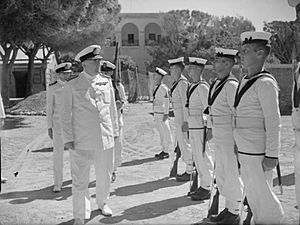Henry Harwood facts for kids
Quick facts for kids
Henry Harwood
|
|
|---|---|

Harwood in Alexandria, August 1942
|
|
| Birth name | Henry Harwood Harwood |
| Born | 19 January 1888 St George Hanover Square, London |
| Died | 9 June 1950 (aged 62) Goring-on-Thames, Oxfordshire |
| Buried |
Goring-on-Thames parish churchyard
|
| Allegiance | |
| Service/ |
|
| Years of service | 1904–1945 |
| Rank | Admiral |
| Commands held | HMS Cumberland (June 1927 – June 1928) HMS Warwick & 9th Destroyer Division (August 1929 – April 1930) HMS London (March 1932 – January 1934) HMS Exeter (September 1936 – August 1939) South American Division of the North America and West Indies Station (25 August 1939 – April 1940) a Lord Commissioner of the Admiralty (December 1940 – April 1942) Commander-in-Chief, Levant Admiral Commanding, Orkneys and Shetlands (April 1944 – March 1945) |
| Battles/wars | |
| Awards | KCB (1939) OBE (1919) MID (1941) War Cross (Greece) (1943) Gold Medal of Concepcion (Chile) (1939) Grand Officer, Order of Merit (Chile) (1940) |
| Relations | Kate Harwood |
Admiral Sir Henry Harwood Harwood (born January 19, 1888 – died June 9, 1950) was a brave British officer. He became famous for his leadership in the Battle of the River Plate during World War II.
Contents
Henry Harwood went to Stubbington House School before joining the Royal Navy in 1904. He chose to specialize in torpedoes, which are underwater weapons. He served during the First World War.
By 1929, he had risen through the ranks to become a captain. He commanded the destroyer HMS Warwick. He also led the 9th Destroyer Division.
In the early 1930s, Harwood studied at the Imperial Defence College. After this, he became the main captain of the large ship HMS London. He also worked as a chief staff officer for the admiral leading the 1st Cruiser Squadron. From 1934 to 1936, he taught at the Royal Naval War College in Greenwich.
In September 1936, Harwood was given command of the South American Division. This meant he was in charge of British naval ships in that area. He also commanded the cruiser HMS Exeter. When World War II began, Captain F. S. Bell took over command of HMS Exeter.
World War II Heroics
Harwood led a group of powerful ships. This group included the heavy cruisers HMS Cumberland and HMS Exeter. It also had the lighter cruisers HMS Achilles and HMS Ajax. Harwood used Ajax as his main ship.

His squadron was sent to the South Atlantic Ocean. Their mission was to find and stop the German warship Admiral Graf Spee. This German ship was attacking Allied merchant ships.
Harwood believed that Graf Spee would attack near the River Plate estuary. This is a wide river mouth. Since Cumberland was away for repairs, Harwood positioned his other three cruisers there. He placed them on December 12.
The famous Battle of the River Plate happened on December 13. Harwood's ships were damaged in the fight. But Graf Spee was also badly hit. She escaped to Montevideo, a city in neutral Uruguay. A few days later, the German crew sank their own ship. They did this to prevent it from being captured. For this great victory, Harwood was promoted and made a knight.
From December 1940 to April 1942, Admiral Harwood worked as an Assistant Chief of Naval Staff. In April 1942, he was promoted to vice-admiral. He became the Commander-in-Chief of the Mediterranean Fleet. Later, his command was split. In February 1943, he became Commander-in-Chief, Levant. His job was to support the British Eighth Army with naval power and supplies.
In April 1944, Harwood took command of the naval forces in the Orkney Islands and Shetland Islands. He retired from the navy on August 15, 1945. He was given the rank of admiral. He retired because he was medically unfit for more duty.
Later Life and Legacy
Sir Henry Harwood passed away in Goring-on-Thames in 1950. A main street in the town of Ajax, Ontario, Canada, is named Harwood Avenue after him. This town is also named after his flagship, HMS Ajax.
In the 1956 movie, The Battle of the River Plate, the actor Anthony Quayle played Sir Henry Harwood.
Sir Henry Harwood held many ranks during his naval career:
- Midshipman (1904)
- Acting sub-lieutenant (1907)
- Sub-lieutenant (1908)
- Lieutenant (1908)
- Lieutenant-commander (1916)
- Commander (1921)
- Captain (1928)
- Commodore 2nd class (1936)
- Commodore 1st class (1939)
- Rear-admiral (1939)
- Vice-admiral (1942)
- Acting admiral (1942)
- Admiral (retired) (1945)
Awards and Decorations
Admiral Harwood received several important awards for his service:
- Knight Commander of the Order of the Bath (December 23, 1939): This high honor was given for his actions against the Admiral Graf Spee.
- Officer of the Order of the British Empire (July 17, 1919)
- Mentioned in Despatches (January 1, 1941): This means his brave actions were officially noted.
- Greek War Cross (April 17, 1943): Awarded for his help to the Greek Navy.
- Gold Medal of Concepcion (Chile) (1939): Given after the Concepcion earthquake in Chile.
- Grand Officer, Order of Merit (Chile) (September 6, 1940): Another Chilean award related to the earthquake relief.
Images for kids



